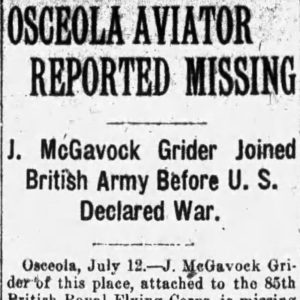calsfoundation@cals.org
John McGavock Grider (1892–1918)
Mississippi County native John McGavock Grider was one of a small number of U.S. pilots who served with the British Royal Air Force in World War I. Shot down in 1918, he is best known for an airfield named in his honor and the postwar publication of a version of his diary by a comrade who initially made no mention of Grider as the author of the account.
John McGavock Grider, the only son of William H. Grider and Sue Grider, was born on May 18, 1892, at Sans Souci plantation near the community of Grider (Mississippi County). As a young man, he followed in his father’s footsteps as a farmer. On March 29, 1909, he married Marguerite Samuels, with whom he had two sons. At some point, the couple moved from Arkansas, but, after a separation and divorce in 1916, Grider returned to his father’s farm.
When the United States entered World War I in April 1917, Grider traveled to Chicago, Illinois, and enlisted as a cadet in the Aviation Section of the United States Army Signal Corps. He completed his initial training at Champaign, Illinois.
Before the United States could organize its own air service, many newly trained pilots were sent to serve with the British. By October 1917, Grider had arrived in England and was stationed in the Oxford area. Here, Grider and two friends, Lawrence Callahan and Elliott Springs, were assigned to No. 85 Squadron of the Royal Air Force. On May 22, 1918, Grider was flying missions over the front lines in France, soon claiming four downed enemy aircraft, two of which were shared. When going into combat, the young pilot carried a doll given to him by British actress Billie Carlton.
Grider had been in France for about one month when he and Springs flew their last mission together on June 18, 1918. While returning to base after they shot down an enemy plane near Armentieres, France, Grider’s plane disappeared. Three days later, Grider’s father received a telegram stating, “Lieutenant Grider reported missing in action June 18, 1918.” Though his body was never recovered, his death was confirmed by a German pilot who flew over, dropping a note describing his burial. His name appears on the Tablets of the Missing at Flanders Field American Cemetery at Waregem, Belgium.
In 1926, Springs, who wanted to be a writer, published War Birds: Diary of an Unknown Aviator. The volume was also published serially in Liberty Magazine. Springs initially made no mention that the publication was apparently based on, at least in part, Grider’s war diary. This was acknowledged in the second edition, when Springs revealed that Grider had given him the diary before his death and expressed a desire that the story be told. In 1927, Grider’s sister sued Springs, receiving a $12,500 settlement. In 1988, Texas A&M University Press published a new edition of War Birds listing Grider as author.
At least three facilities have been named in Grider’s honor. On March 22, 1941, Grider Army Air Field became operational near Pine Bluff (Jefferson County); it is now part of Pine Bluff’s municipal airport. A now-defunct Veterans of Foreign Wars post, Grider Post No. 2, was established in Osceola (Mississippi County), and that city also has the McGavock-Grider Memorial Park.
For additional information:
Edrington, Mabel. History of Mississippi County, Arkansas. Ocala, FL: The Ocala Star Banner, 1962.
“Osceola Aviator Reported Missing.” Arkansas Gazette, June 13, 1918, p. 7.
Risher, Wayne. “Diary Cinches Flier’s Role in War Birds as WWI ‘Tragic Hero’ Says Producer.” Memphis Commercial Appeal. February 10, 2002, pp. 1A–2A.
Springs, Elliot, ed. War Birds: Diary of an Unknown Aviator. College Station: Texas A&M University Press, 1988.
“Unknown Aviator.” Arkansas Gazette. November 2, 1930, p. 9.
Wallis, David. “John McGavock Grider.” Jefferson County Historical Quarterly 7.3: 4–11.
Ward, Helene I. “Grider Field is Dedicated in Pine Bluff.” Arkansas Democrat. May 25, 1941, pp. 1–2.
Mike Polston
CALS Encyclopedia of Arkansas
 Grider Missing Article
Grider Missing Article 




Comments
No comments on this entry yet.